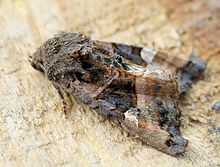Small angle shades
| Small angle shades | |
|---|---|
 | |
Scientific classification | |
| Kingdom: | Animalia |
| Phylum: | Arthropoda |
| Class: | Insecta |
| Order: | Lepidoptera |
| Family: | Noctuidae |
| Genus: | Euplexia |
| Species: | E. lucipara |
Binomial name | |
Euplexia lucipara (Linnaeus, 1758) | |
The small angle shades (Euplexia lucipara) is a moth of the family Noctuidae. It is distributed throughout the Palearctic.
As the common name suggests, this species is closely related to the angle shades (Phlogophora meticulosa), and is considerably smaller (wingspan 30–35 mm), but does not especially resemble that species. The forewings are dark brown with a broad, pale subterminal band, wider and paler towards the costa. The hindwings are whitish at the base, graduating to brown at the margins. In the British Isles this species flies at night in June and July, with a second generation sometimes emerging in September. It is attracted to light and sugar.
Contents
1 Distribution
2 Technical description
3 Biology
4 Gallery
5 Notes
6 References
7 External links
Distribution
Throughout Europe, in Algeria, in western Asia and through the Palearctic to Siberia, China, and Japan.
Technical description
Forewing rufous ochreous tinged with purplish and mixed with olive brown;median area, a triangular blotch on inner margin near base, and a narrow praesubmarginal cloud deep olive; costa to beyond middle, the terminal area, and the orbicular stigma leaden purple; lines indistinct, the outer and inner approximating on inner margin; claviform stigma olive, dark-edged; orbicular roundish, oblique, with paler ring; reniform conspicuously whitish, containing a double brown lunule; submarginal line pale, waved; veins towards termen dotted dark and pale; hindwing ochreous with dark cell mark and veins, darker in terminal half where there is visible a dark pale-edged outer and submarginal line.[1]
Biology
Larva velvety green with darker green oblique subdorsal stripes; tubercles pale; spiracular line yellowish white;11th segment slightly swollen, with a pair of white dots; head green.
The larvae often feed on ferns and the species is usually associated with them. Other recorded food plants include birch, false bindweed, dogwood, larkspur, willowherb, ash, ivy, lettuce, privet, loosestrife, oak, buttercup, currant, raspberry, willow, tomato, coltsfoot, nettle, and guelder rose.[2] The species overwinters as pupae.
Gallery

Illustration from British Entomology, Volume 5, by John Curtis
Notes
^ Seitz, A. Ed., 1914 Die Großschmetterlinge der Erde, Verlag Alfred Kernen, Stuttgart Band 3: Abt. 1, Die Großschmetterlinge des palaearktischen Faunengebietes, Die palaearktischen eulenartigen Nachtfalter, 1914
^ "Robinson, G. S., et al. 2010. HOSTS - A Database of the World's Lepidopteran Hostplants. Natural History Museum, London"..mw-parser-output cite.citation{font-style:inherit}.mw-parser-output .citation q{quotes:"""""""'""'"}.mw-parser-output .citation .cs1-lock-free a{background:url("//upload.wikimedia.org/wikipedia/commons/thumb/6/65/Lock-green.svg/9px-Lock-green.svg.png")no-repeat;background-position:right .1em center}.mw-parser-output .citation .cs1-lock-limited a,.mw-parser-output .citation .cs1-lock-registration a{background:url("//upload.wikimedia.org/wikipedia/commons/thumb/d/d6/Lock-gray-alt-2.svg/9px-Lock-gray-alt-2.svg.png")no-repeat;background-position:right .1em center}.mw-parser-output .citation .cs1-lock-subscription a{background:url("//upload.wikimedia.org/wikipedia/commons/thumb/a/aa/Lock-red-alt-2.svg/9px-Lock-red-alt-2.svg.png")no-repeat;background-position:right .1em center}.mw-parser-output .cs1-subscription,.mw-parser-output .cs1-registration{color:#555}.mw-parser-output .cs1-subscription span,.mw-parser-output .cs1-registration span{border-bottom:1px dotted;cursor:help}.mw-parser-output .cs1-ws-icon a{background:url("//upload.wikimedia.org/wikipedia/commons/thumb/4/4c/Wikisource-logo.svg/12px-Wikisource-logo.svg.png")no-repeat;background-position:right .1em center}.mw-parser-output code.cs1-code{color:inherit;background:inherit;border:inherit;padding:inherit}.mw-parser-output .cs1-hidden-error{display:none;font-size:100%}.mw-parser-output .cs1-visible-error{font-size:100%}.mw-parser-output .cs1-maint{display:none;color:#33aa33;margin-left:0.3em}.mw-parser-output .cs1-subscription,.mw-parser-output .cs1-registration,.mw-parser-output .cs1-format{font-size:95%}.mw-parser-output .cs1-kern-left,.mw-parser-output .cs1-kern-wl-left{padding-left:0.2em}.mw-parser-output .cs1-kern-right,.mw-parser-output .cs1-kern-wl-right{padding-right:0.2em}
References
- Chinery, M. Collins Guide to the Insects of Britain and Western Europe. 1986 (Reprinted 1991)
- Skinner, B. Colour Identification Guide to Moths of the British Isles. 1984
External links
| Wikimedia Commons has media related to Euplexia lucipara. |
- Small Angle Shades up UKmoths
Funet Taxonomy- Lepiforum.de
- Vlindernet.nl (in Dutch)
